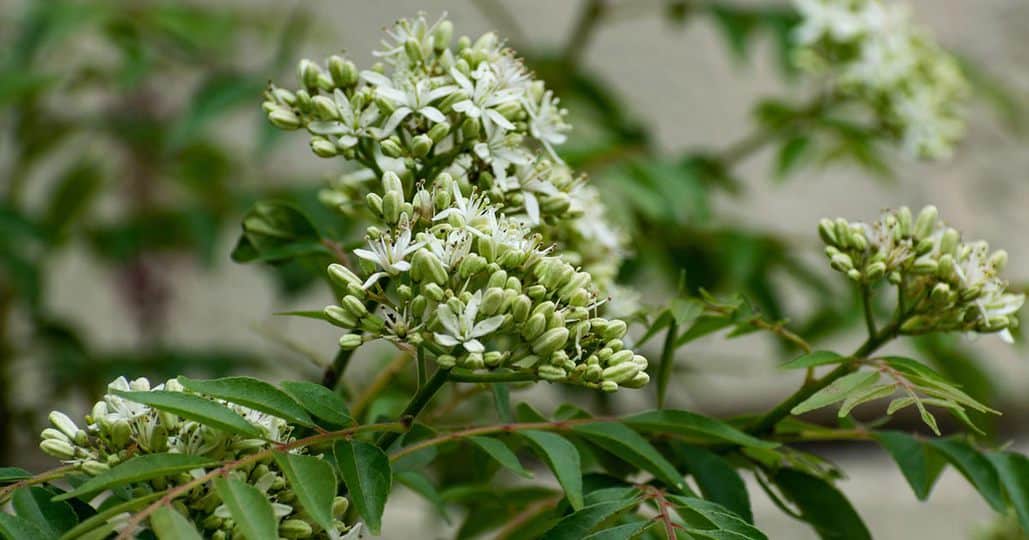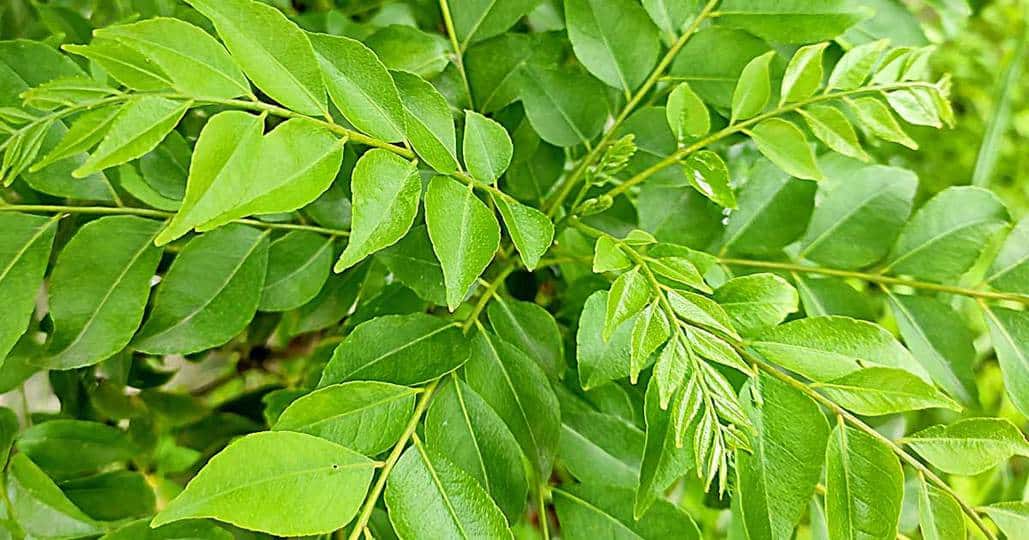For most of the Curry leaf plant owners, caring for a Curry Leaf Plant is nothing sort of caring for a pet! Well, not exactly the same, but if you have managed to kill your curry leaves plant before, you know what I mean! In this Curry leaf plant care guide, I’ve compiled and sorted the tips and tasks for each season, to make it easier for you to follow along. Now you don’t have to wonder how to protect the young curry leaf plant during winter and when is the right time to move it outdoors again in spring.
Curry Leaf plants also known as Limdo, Limdi or Kaddi Patta, are native to the tropical part of India and Southern Asia. It cannot survive cold weather without protection. If you are growing a Curry Leaves Plant in the USA, Canada, or Europe, where the temperature goes below freezing (32F) in Winter, you need to take extra care of the Curry Leaf Plant.
In this article, you will find tips and ‘to-do’ list for the precious Curry Leaves plant care during all four seasons. Before we go into the details, a few things to remember:
Curry Leaf Facts:
1. Curry Leaf Plant will die if it is exposed to the freezing temps. If the temperature frequently dips below 32F in your area during winter, plant the curry Leaf Plant in a container for easy mobility during different seasons. As mentioned in the Curry Leaf Buying Guide, make sure you have a space to store the plant indoors during winter months.
2. One of the most common reasons a Curry Leaf Plant dies for the first-time owners is due to over-watering. Make sure to follow the below guidelines to understand how much to water during different seasons.
3. If you recently became a young curry leaf plant parent, follow this guide to transplant a curry leaf plant into a new pot. Make sure to keep the newly planted Curry leaf plant hydrated without over-watering it and in a shaded area for a few weeks. Do not fertilize the young plant for the first 6 months. Fertilizing the plant too soon can burn the roots and damage the plant permanently.
Here is the summary table of how to care for the curry leaf plant during all four seasons. Different parts of the word experience seasons during different months. So rather than using months, I am using temperature as a rough guideline to distinguish between seasons.
Seasonal Curry Leaf Plant Care Chart
| Spring (40F to 85F) | Summer (85F and above) | Fall (Below 80F) | Winter (Below 40F) | |
| Transplanting | Do | Don’t | Do if Needed | Don’t |
| Pruning | Do | Don’t | Do if Needed | Don’t |
| Fertilizing | Do | Do | Don’t | Don’t |
| Sunlight | Full Sun | Partial Shade | Full Sun | Sunny Window/ Artificial light |
| Watering | Weekly | Every 2 to 4 days | Weekly | Every 3 to 4 weeks |
| Watch Out For | Scales | Spider Mites, Black spots | Spider Mites, White Flies | Scales, Spider Mites, White Flies, Fungus Gnats |
Now let’s begin! You can either read the entire article for a complete understanding of how to care for your Curry Leaf Plant. Alternatively, quickly jump to a particular section if you want to look up what to do during that season.
Curry Leaf Plant Care Tips For Spring:
1. Bring the plant outside:
Wait for the last frost of the spring to pass before bringing the curry leaf plant outdoors. (Look up the last spring frost date in your area here). Once the night time temperature is consistently above 40F, it is safe to bring the curry leaf plant outside.
- Water to the plant thoroughly.
- Put the plant in part shade and protected area for 3 to 5 days. Let it adjust to the outside environment slowly before exposing it to the elements. The screened porch, north/east side of the house, or under the deck are perfect places.
- Curry Leaf plant loves full sun. Once the plant is outside for a few days, move the plant in an area where it can get at least 6 to 8 hours of direct sunlight.
- If the temperature is predicted to drop below 35F, protect the plant with a Plant protector, or completely cover the plant and the pot with Floating row cover. I always have these handy during early Spring, so I can quickly pull them out when the weather app alerts me of a frost warning.
2. Change the pot/soil:
Spring is the perfect time to transplant the curry leaf plant into a larger pot or to change the soil.
- For the first 3 to 4 years, the plant needs to be re-potted into a bigger container each year to give the plant space to grow more roots. After that, the plant can be re-potted every other year.
- Here is a guide to transplant a curry leaf plant into a new container.
- Over time, the nutrients from the soil are washed out or used up by the plant. It is essential to replenish nutrients with fresh soil to grow a healthy plant. For a mature plant, if it’s not being re-potted to a new container, replace the top 30% to 50% soil with a fresh potting mix + compost mixture. Use a fork to gently scrape out the dirt without disturbing the roots. Then tilt the container to empty out the old soil, and refill the container with new soil mixture.
- Add a granular all-purpose fertilizer to the pot at this time.
- Don’t forget to water thoroughly after transplanting or replenishing the soil.
3. Prune the Curry Leaf Plant:
Just like re-potting, the major pruning of the Curry Leaf Plant should be done in the spring. It can be done at the same time the plant is re-potted. Read this for detailed step-by-step instructions on how to prune a curry leaf plant.
- Start by removing old, yellow leaves. Remove stems that have lost the leaves.
- Make a clean diagonal cut with a sharp pruner, at least 1/3 from the top of the plant. This may seem harsh, but it is necessary to contain the plant’s size and make the plant bushier.
- If the mature plant has developed thick branches, they can be cut back by ½ to 1/3 of the length.
- Within 2 to 3 weeks, the plant will shoot out multiple branches just below the cut. More branches mean more leaves later in the season!
4. Fertilize the Curry Leaf Plant:
After 2 weeks of re-potting the plant, start applying Seaweed and fish fertilizer to the curry leaf plant. For the vegan and Jain gardeners, Liquid Kelp is an Animal-free fertilizer option.
- Here is more information on homemade and other natural fertilizers for the curry leaf plant.
5. Watering the Curry Leaf Plant:
- Young curry leaf plants are very vulnerable to root rot. DO NOT OVER-WATER the curry leaf plant. Do a visual inspection to make sure the plant needs water before each watering. Dry soil feels lighter in color, and the pot feels lighter in weight.
- It is better to water the curry leaf plant thoroughly but infrequently. Make sure to let the soil dry out between the watering.
- In the Spring, watering only once a week is sufficient. If the plant gets water through rain, delay watering the plant until the topsoil feels dry to touch.
- For beginners, it is worth investing in a plant water meter. Just insert the prob into the soil, and the meter will let you know if it’s time to water the plant! Your curry leaf plant will thank you for this!
6. Protect the Curry Leaf Plant from pests:
As new growth starts to appear on the curry leaf plant, insects such as Scales and Aphids are attracted to the plant. They love sucking and snacking on the new leaves and branches. It is easier to proactively prevent these bug infestations than getting rid of them once they arrive.
- Start applying Neem oil spray every two weeks interval. Neem oil helps control harmful insects and protect the plant from fungal and bacterial infections. Here is the recipe to make your own Neem Oil Spray.
- Once a month, hose down the plant with sharp water spray.
- If the bug infestation does occur on the plant, other remedies may need to be applied to eliminate the bugs.

7. Remove flower buds from the plant:
In a year or two, the curry leaf plant will start producing pretty little flowers at the tip of the branch. If let it grown on the plant, these flowers will produce seeds later in the season. While the flowers mature and turn into fruits, the plant diverts most of the energy in nourishing these flowers. This significantly slows down the growth of the plant. So, unless you have a specific reason to grow the curry leaf seeds, promptly remove the flower buds from the plant.
Curry Leaf Plant Care Tips For Summer:
Once the daytime temperature hits 80F consistently, it’s time to slightly change the routine for the curry leaf plant. Here is a list of tips to care for your Curry Leaf Plant during Summer.
- Unless absolutely necessary, avoid changing the pot and soil during summer months.
- Move the pot with a curry leaf plant into a partly shaded area such as a screened-in porch, under a large tree, or on the east side of the house.
- If you have acquired a new baby curry leaf plant recently, quickly transplant it into another pot. Do the transplanting on a mild, cloudy day. Keep the pot in a shaded area for a few weeks.
- During Summer, water the plant every 2 to 4 days, depending upon the weather and the pot size. Make sure to let the soil dry out between watering. Use the Plant Moisture Meter to be extra sure.
- Continue applying Seaweed or liquid Kelp fertilizer or home made fertilizer every other week.
- Continue spraying the plant with Neem oil insecticide spray every 15 days. Do not spray Neem Oil on the day when the temperature is expected to go beyond 90F.
- Watch out for the black spot disease on the plant.
- Continue harvesting stems from the mature curry leaf plant. Avoid harvesting leaves from a plant that is younger than 2 years.
Care For Curry Leaf Plant In Fall:
When the weather starts to cool down in Fall, it’s time to help the curry leaf plant prepare for the dormant time indoors during winter months.
- Move the pot back into full sun location where it receives 6 to 8 hours of direct sunlight.
- If needed, re-pot the curry leaf plant in early fall. Give the plant at least 4 weeks to adjust into the new pot before it’s time to bring the pot indoors.
- Cut back on the watering. In cooler weather, the plant does not need much watering. Deep watering once a week should be enough. Again, check to see if the plant is thirsty before watering.
- Do not apply any fertilizer to the curry leaf plant in Fall. Fertilizers force the plant to put out new leafy growth, which is very sensitive to cool air. Fertilizing the curry leaf plant late in the year will do the plant more damage than good.
Prepare the plant to bring indoor:
As soon as the night time temperature falls near 40F, prepare the plant and the pot for indoor storage.
- If needed, lightly prune the plant to make the size suitable for indoor storage.
- Hose down the plant top to bottom with sharp spray to remove any bugs that are hiding under the foliage. Make sure to spray over and under the leaves and under the pot.
- Apply Neem oil soil drench with Peppermint oil at the surface of the potting soil. This will kill any bugs and larva that are living under the soil surface, such as Centipedes.
- Keep the plant protecting blankets on hand if you are not ready to bring the pot inside when an early frost is predicted.
How to protect a Curry Leaf Plant in Winter:
Curry Leaf plant is a tropical plant and very sensitive to cold weather. It cannot survive if exposed to the freezing temperature of 32f or lower. Plan to make room in the house, basement, or garage to store the Curry Leaf plant during winter.
Here are some tips, dos, and don’ts for winter care:
- Do not wait for the First fall frost to bring the curry leaf plant indoors. (Look up the expected First frost date of your area). Take the plant indoors as soon as the nighttime temperature drops to 40F.
- Ideally, put the plant near a sunny window indoors. If it is not possible, store the plant in a garage, basement, or an extra room.
- If stored inside, make sure the plant is not in the direct draft of the heat vent. The constant flow of hot air will dry out the plant.
- The Curry leaf plant’s need for water during winder decreases significantly. Do not over-water the plant while indoors. Only water once every 3 to 4 weeks, so the plant doesn’t dry out completely. There is no need to drench the soil with water.
- Do not expect the plant to grow while indoors.
- While dormant, it is normal for the plant to lose all leaves or for the leaves to change color to pale Yellow. Don’t worry, the new leaves will grow when the plant is moved outdoors in spring.
- If you want to continue harvesting the green leaves during winter months, set up an indoor grow light over the curry leaf plant.
One last thing: If you think the plant is dead at the end of the winter, do not throw it away. I had a curry leaf plant that turned into a stick during winter, but revived on its own after 6 months!
Controlling the Curry Leaf Plant pests:
The Curry leaf plant can be infested with bugs such as Scales, Spider mites, Whiteflies, Aphids, and Fungus gnats while indoors. Since there are no natural predators indoors to control the population of these bugs, they multiply rapidly. It is critical to take action to eliminate the bugs as soon as you spot them.
If the edges of the pot or area around the pot feel sticky to the touch, that’s a sure sign of bug infestation.
- Wipe down the branches and stems with wet paper napkin to get rid of Scales.
- Spray with neem oil spray when you see Aphids on the plant.
- Apply Neem oil soil drench to the potting soil to kill insect larva in the soil.
- Put Yellow sticky papers around the plant. These will attack and trap flying insects such as Fungus Gnats and White flies.
- Put a bug zapper near the Curry Leaf Plant container to trap flying insects.
There you have it! Everything you need to know about growing a curry leaves plant. If you still have a question, join the Pinch of seeds group on Facebook, or leave a comment below.
P.S. If you find this information helpful, don’t keep it to yourself! Share the link of this article on your Facebook page or gardening group. Somebody may just thank you for it!
Pin this Curry Leaf Plant Care post for a visual reminder
Would you like to be refer to this seasonal curry leaf plant care guide frequently? Just pin this image to one of your Pinterest gardening boards so that you can easily find it later when you need it.

Last Updated: 1/25/2024


Hello gopi, my curry plant is all brown and the tip is not growing. I repotted it in Few weeks ago to a bigger pot. There are no new leaves, there is just 2 long thin stem and the tip isn’t growing. I don’t understand what is the problem. Can you suggest me some thing so that I can grow back my curry plant.
Thank you.
Hi Zee,
Newly transplanted curry leaf plant takes a few months to settle down in the new soil and the pot. Be patient, the new growth will start as the weather gets warmer. Continue watering the plant on regular bases.
-Gopi
Thanks for the information on growing & caring curry plant . Very well written post. I have currently have curry plant in 2 pot. I have had them for past 4 year or so. In one pot there are so many little plants coming but its not growing tall. What should be done?
The other curry plant in a different pot is growing tall but very thin. I have pruned in the past (not as you had mentioned) and not many branches came out. What would be your suggestion.
Hi Gopi,
Nice article.
I hope my husband succeed this time with his curry plant following your tips. It is his 4th attempt. Not sure why he is so passionate with Curry plant :-).
-Renu
Hi Gopi,
This is very helpful information. I have messaged you on FB. If you can reply that would be great. Thanks,
Very informative..Can you please share pictures to properly prune the plant
Hello. My curry leaf plant has started to look strange. Leaves are yellowing with dark patches on them. The stems are turning red. Any advice? I’m in zone 8a northeast Texas.
Hi Gopi,
Thank you for this amazing article. I finally have all the info I was looking for to save my beautiful plant. I have had the plant for 3 years now and it was shedding lot of leaves as we live in a windy area. I have not reported my plant since 3 years. Now when I plan to repot the plant I see little buds coming and hesitant to repot again. What do you suggest I do.
Should I repot the plant despite that it is flowering for the first time or should I go ahead and repot it anyway ?
I am looking forward to hear from you
Hi Aishwarya!
If the curry leaf plant is growing in the same pot for 3 years, it is time to transplant the curry leaf plant into a bigger pot with new soil. The existing soil may have depleted out of the nutrients.
I would remove the flowering bud from the curry leaf plant, so the plant can focus on growing more leaves and roots rather than flowers.
-Gopi
Thanks Gopi ❤️
Hi thanks for your detailed information on how to look after curry leaf plants. My problem is that I got three of these plants and they are all in the ground outside. It does get enough sun in summer and winter. But since I live in Canberra Australia where it doesn’t snow but the winters are very cold and severe with heavy frost.
So my question is, can I protect them by covering by some frist protecting cloths.This summer I planted them in my yard outdoors and all three are very healthy. So far I was keeping them in pots and was moving them indoors from last three years. Now it might be not safe to put them back in pots because the roots are well developed and spread out in the ground.
Since they are outside now, is there any good way I can protect them outside this coming winter.
By the way officially today is the last day of summer in Australia. I must act fast to protect them.
Please advise me. Thanks
Razi
Hello Razi!
If it gets below 25F in your area, even if the plant is protected with cloths, the curry leaf plant will most likely not survive. It is best to transplant the curry leaves plant into a pot and bring it indoors during winter time.
– Gopi
The article is very useful but I think I found it a little late… We live in San Jose and my curry leaf plant was indoors all winter and by the end like in the last month it developed sticky residue and brown spots on the branches and leaves. Currently we lost all leaves I’ve cleaned the plant with warm water and applied neem oil. Worried if the plant will survive ☹️
Hi Vyshnavi! It seems that the Curry leaves plant has scale issue. Those are little insects that sticks to the branch and leaves of the curry leaf plant and suck the nectar out of it. You can use neem oil spray every 3-4 days on top and bottom of the curry leaves as well as covering the branches. Most likely the plant will survive once it is placed outdoors.
Hope this helps!
-Gopi
Thanks Gopi for such a detailed description on how to care for curry leaves plant for a new plant parent like me. Cheers!
Thank you Garima for your kind words! I am glad you like the Curry Leaf Plant Care guide helpful!
the information you have provided is very helpful. Thank you for taking time to share the instructions to grow Curry leaves.
Thank you for your kind words!
-Gopi
Hi Gopi
If I have a grow light and grow tent to put my curry leave plant in, what humidity levels should I aim for and how much light in 24hrs?
Thanks
Alistair